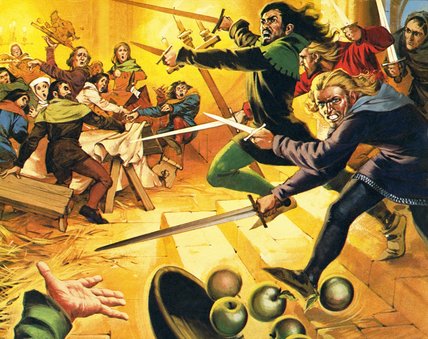|
Also known as Marchmount, only fragments
survive of what was once the most extensive and powerful castle in the borders.
It occupied a site some 360 metres long and 90 metres wide, a curtain wall with
corner towers once encircled the whole area but now only fragments remain along
the south side.
It is not known exactly when the hill was first
fortified but it was a fortress as far back as the Saxon Kingdom of Northumbria.
It was a favourite residence of David I, before and after his accession, it was
he who made it a royal palace. His successors, Malcolm IV, William the Lion and
Alexander's II and III all stayed here.
In 1124, Malcolm, son of MacBeth, was
imprisoned in one of towers and, 22 years later his own son, Donald was held
here. Roxburgh, along with Edinburgh and Stirling Castles were handed over to
the English as security for the ransom demanded by Henry of England for the
release of William the Lion after his capture at the Battle of Alnwick in 1174. King
David planned and supervised his border abbeys from here and, in 1239 Alexander
II married Mary de Couci here, his son, Alexander III was also born in the
castle.
John Balliol presented Roxburgh Castle to
Edward I of England in 1290 and two years later the English king
celebrated the Feast of Pentecost here.
William Wallace was unsuccessful in an attempt
to win it back in 1297 while trying to rescue Robert Wishart, Bishop of Glasgow,
who was being held here.
It was won back in March 1313(1) by Sir James 'the
good' Douglas and a group of around sixty men. They gained entry by using hemp
ladders with hooks attached to scale the walls, surprising the garrison who were
all feasting in the great hall. The warden and a few men took to the keep but
surrendered the following day. Bruce then ordered the demolition of the
fortifications, as he had with most castles, to prevent further occupation.
Mary, Bruce's sister had earlier been hung in a cage from the castle walls, she
was later released.
The Treaty of Northampton in 1329 gave Roxburgh
to the the Scots, but during the reign of Bruce's son, David II, the son of John
Balliol, Edward, who was contesting the throne, gave Roxburgh to his backers,
the English, who repaired the damage done by Bruce. It was won back again in
1341 by Sir Alexander Ramsay of Dalhousie. He put the 40 strong garrison to the
sword and was rewarded with the Governorship of Roxburgh and Sheriffdom of
Teviotdale. The English regained possession in 1334 and attempts to win it back
by the Douglas and James I were unsuccessful, it was to remain in English hands
for over 100 years.
In 1460 a large army led by James II laid siege
to the castle after totally demolishing the town of Roxburgh. On Sunday 3rd
August, not long into the siege a Flemish gun, known as the Lion, burst on
firing, killing the King instantly and severely wounding the Earl of Angus,
George Douglas. Word was sent to James' queen, Mary of Gueldres, requesting that
she attend and to bring the 8 year old Prince James with her. On her arrival she
urged the army to continue with the siege, which they did by storming and
winning the castle the same day. The fortifications were once again
demolished, though were partly rebuilt a few years later. The young James III
was crowned at Kelso Abbey a week later.
In 1547 the Earl of Somerset, returning home
from the Battle of Pinkie, made repairs to the buildings and left a garrison of
500 men. Three years later a treaty between Scotland's ally, France, and
England, bound them to demolish the two Scottish castles they still held,
Eyemouth and Roxburgh. The demolition was duly carried out and for the first
time in centuries Roxburgh Castle was at peace.
In 1574 James VI granted the castle to Robert
Ker of Cessford, from whom the Dukes of Roxburgh are descended. Floors
Castle, the palatial mansion house which is home to the Dukes can be seen
from the hill. This was built for the 1st Duke, starting in 1718, to a
design by Sir John Vanburgh, William Adam was involved in the latter stages of
it construction. It was completely remodelled by William Playfair, on behalf of
the 6th Duke, between 1838 and 1849. It has been described as the largest
inhabited mansion in the U.K. This was the house used in the 1983 film;
Greystoke: The Legend of Tarzan, Lord of the Apes.
 |
| James Douglas
attacking Roxburgh Castle; Angus McBride |
On one occasion Roxburgh
Castle was re-captured by the Douglases. Black Douglas led is men
over the walls and into the castle. Stealthily exploring the nearest rooms,
Douglas came upon a women singing her child to sleep. As she sang ‘The Black
Douglas shall not get ye,’ a leather-gloved hand was laid on her arm and a
voice said: ‘I am not so sure of that!’
It was Black Douglas himself!
|


